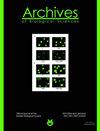17-烯丙基氨基-17-去甲氧基格尔达霉素与去羟基甲基氧氧喹啉霉素对人间变性甲状腺癌细胞KTC2的协同作用
IF 0.8
4区 生物学
Q4 BIOLOGY
引用次数: 0
摘要
靶向抑制剂的使用已经显示出作为一种有效的癌症治疗方法的希望。然而,仅基于一种药物的靶向治疗,如17-烯丙基氨基-17-去甲氧基格尔达霉素(17-AAG),取得的成功有限,部分原因是癌细胞通过其他途径存活和增殖。在本研究中,我们研究了核因子B (NF- B)抑制剂dehydroxymethylepoxyquinomicin (DHMEQ)是否能增强90 kDa热休克蛋白(Hsp90)抑制剂17-AAG在间变性甲状腺癌细胞KTC2中的抗肿瘤活性。我们检查了联合药物治疗与单一药物治疗对细胞存活的影响。采用等线图分析来区分药物组合的加性和增效作用。Western blotting检测细胞凋亡标志物:caspase 3、聚(adp -核糖)聚合酶1 (PARP-1)、b细胞淋巴瘤-特大(Bcl-XL)、x -连锁细胞凋亡抑制剂(XIAP)和细胞凋亡抑制剂2 (cIAP-2)。与单药治疗相比,联合治疗以协同方式增强了生长抑制作用,并强烈增强了细胞凋亡。这些结果首次在体外证明了Hsp90和NF-?B抑制剂在抑制间变性甲状腺癌细胞增殖和存活方面比单独使用任何一种药物都更有效,值得进一步研究。本文章由计算机程序翻译,如有差异,请以英文原文为准。
Synergistic effect of 17-allylamino-17-demethoxygeldanamycin with dehydroxymethylepoxyquinomicin on the human anaplastic thyroid carcinoma cell line KTC2
The use of targeted inhibitors has shown promise as an effective approach in cancer therapy. However, targeted therapies based only on one drug, such as 17-allylamino-17-demethoxygeldanamycin (17-AAG), have limited success, partly because cancer cells engage alternate pathways for survival and proliferation. In the present study, we evaluated whether dehydroxymethylepoxyquinomicin (DHMEQ), a nuclear factor ?B (NF-?B) inhibitor, can enhance the antitumor activities of 17-AAG, a 90 kDa heat shock protein (Hsp90) inhibitor, in the anaplastic thyroid cancer cell line KTC2. We examined the effect of combined drug treatment vs single drug treatment on cell survival. Isobologram analysis was performed to distinguish the additive vs synergistic effects of the drug combination. Western blotting was performed to investigate apoptosis markers: caspase 3, poly(ADP-ribose) polymerase-one (PARP-1), B-cell lymphoma-extra large (Bcl-XL), X-linked inhibitor of apoptosis (XIAP) and cellular inhibitor of apoptosis 2 (cIAP-2). Compared to monotherapy, the combined treatment enhanced growth-inhibitory effects in a synergistic manner and strongly potentiated apoptosis. These results demonstrate the first in vitro evidence that a combination of Hsp90 and NF-?B inhibitors is a more effective modality for inhibiting cell proliferation and survival in anaplastic thyroid carcinoma cells than either agent alone, warranting further investigations.
求助全文
通过发布文献求助,成功后即可免费获取论文全文。
去求助
来源期刊
CiteScore
1.40
自引率
0.00%
发文量
25
审稿时长
3-8 weeks
期刊介绍:
The Archives of Biological Sciences is a multidisciplinary journal that covers original research in a wide range of subjects in life science, including biology, ecology, human biology and biomedical research.
The Archives of Biological Sciences features articles in genetics, botany and zoology (including higher and lower terrestrial and aquatic plants and animals, prokaryote biology, algology, mycology, entomology, etc.); biological systematics; evolution; biochemistry, molecular and cell biology, including all aspects of normal cell functioning, from embryonic to differentiated tissues and in different pathological states; physiology, including chronobiology, thermal biology, cryobiology; radiobiology; neurobiology; immunology, including human immunology; human biology, including the biological basis of specific human pathologies and disease management.

 求助内容:
求助内容: 应助结果提醒方式:
应助结果提醒方式:


